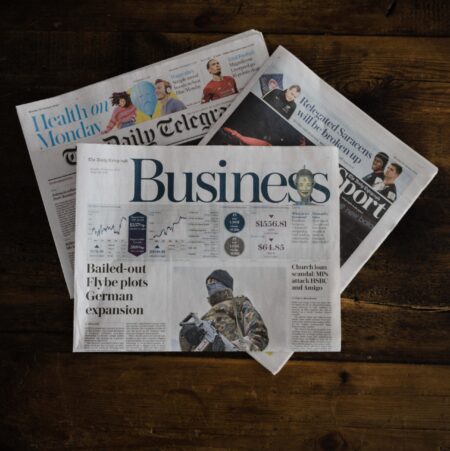Hoping to spin some sassy headlines? Looking to inject life into your lines?
Take a Crash Course in How to Write Headlines that are Sassy as Hell
So you want to write headlines that boomerang off the page and bitch-slap your future customers into buying? I like your enthusiasm, but for some headline writing we’re going to want to tone it down just a bit.
The level of enthusiasm in your headlines has to do with writing voice; and that’s dictated by the targed audience, mood, and other specifics. Direct response copywriting, for example, generally demands hard-hitting headlines that pack a wallop.
Headline Writing Styles to Play with and Customize
When it comes to headline construction, there is no “one size fits all” formula. But we do have some different headlines styles that do their best work for specific types of media. These include:
- Feature article headlines for magazines and trade publications
- Web article titles and headings
- Press release headlines
- Sales page headlines
- Social media headlines
Feature article headlines lend themselves best to wordplay and persuasion.
Web article titles and headings should balance keywords with a strong hook.
Press release headlines relay news and display third person perspective.
Sales page headlines master the art of head-turning, and attracting search engines simultaneously.
Social media headlines place the most important words first.
A web article headline wouldn’t be appropriate for a magazine, because of the keyword differential. A salesy headline might not be the right approach for a feature story.

Let’s Write a Fake Headline, for Practice and for Fun
As a fellow word nerd, you likely delight in writing for fake clients at any given opportunity. We definitely do over here. So let’s have some creative fun with headline writing. We’ll practice the craft of headline creation for a fictitious client right now. Who’s our fake client going to be? How about a shoe company?
A few facts about this fictitious footwear creator
1. They just launched their new Web site, AmazingFeet.com.
2. Their signature product is “shoes that look AND feel great.”
3. They’re running a 2-for-the-price-of-one sale and need to inform their customers of this news.
That said, let’s run through our headline crafting process for various types of media, taking note of the differences between them.
1. The Magazine Article Headline
If the Shoe Fits: Tips on Finding Footwear That’s Both Comfy and Attractive
Good magazine article headlines typically include a clever play on words, but if one doesn’t come, don’t force it. Better to get to the point simply and intelligently than turn an awkward phrase that makes you sound like a novice.
Magazine headlines are frequently a short headline/supporting subhead combo. Where you see the colon above would actually be a line break on the magazine page. The first part, “If the Shoe Fits,” would be blown out in a larger font.
This type of headline can be written in either the second or third person, depending on the context. If you’re reporting a story, stick to third person or omniscient perspective. If this will be an informative article, then it’s okay to use the words “You and Yours” in the headline as well as throughout the text, as you’re speaking “to” the reader in this instance.
The headline shown above works for an advice article. If the article was a human interest feature that told a story about the entrepreneurs behind this particular business, this headline might say something like:
Women With Sole: Meet the Masterminds Behind Today’s Fastest Growing Designer Shoe Brand
(assuming of course, that this is the case!).
2. The Magazine Ad (or Print Ad) Headline
Treat Your Feet.
At first glance, this may seem like a rather lackluster headline. New writers often assume that “longer is better,” and that may be true in the case of web article headlines at least part of the time, but not ads. In fact – many award-winning ads contain headlines of as few as one or two words!
It goes without saying that a magazine ad headline should be persuasive. How are the above three words persuasive? You want to be good to your feet, right? The headline insinuates that “treating your feet” is likely to happen if you keep reading and find out how.
When brainstorming your ad headline, it helps to envision the headline as it will appear on the page. I imagined this one in a stylistically simple, thin but large font, accompanied by a graphic of a fabulous foot wearing a dynamite pair of sandals, maybe doing a gleeful kick. Team up with the designer to discuss concepts. If you can dream up some clever plays on words that match the photo, by all means toss the ideas out there.
Because advertisements are persuasive and subjective in nature, it is always acceptable to speak in the second person. In fact, it’s encouraged. An ad headline should never be written in the way that a news headline would, with the bare facts presented (see news headline, below).
3. The News Story Headline
Amazing Feet Launches New Site, Invites Shoe Shoppers to Try Them On For Size
The above example shows a news headline delivering basic facts about the story that will follow. This type of headline can be used in either a newspaper or web news headline, press release or press announcement.
Because news stories are factual and objective rather than subjective, their headlines should never “speak to the reader” using the second-person or “you” perspective. The news headline gives the first taste of the “who, what, when, where, how and why” that’s to come in the supporting paragraphs. Therefore, write it in the third person “outsider” perspective.
News headlines frequently employ the “comma splice” which is not typically used in other types of headlines. The comma splice was likely introduced in the news reporting context because it’s a space saver. Publishers and editors are always trying to fit wordy headlines on a single line, and the comma splice helps achieve this by omitting a few words.
4. The Web Site Headline
Shoes to Shine In: Step Out in Comfort and Style!
Here, I have included the word “shoes” as an obligatory keyword that may or may not help build rank on the search engines for this fictitious shoe Web site. If I wanted to be really diligent about my keyword use, I’d craft a different headline that opened with the words “Ladies Shoes” or “Women’s Shoes.” Those who religiously employ other search engine tactics; for example, keyword linking to your site from the outside, and including keywords in your metatags, page title, alt tags, and a generous sprinkling of them throughout your web copy… can actually get away with not having keywords in the headline at all!
Because this is clearly a Web site that attempts to sell things, I have written the headline in second person, emphasizing the “you” and the “what’s in it for you.” Notice also that the headline employs an active verb — “step” — that lends an energizing effect and encourages the reader to take action. Why is this headline NOT appropriate for a magazine feature story or Web article? Because it is NOT informative, nor does it tell a story. Classic sales copy should not be confused with other styles of writing. It is appropriate for a magazine ad or sales page, as in a Web site or catalog copy, or basically anywhere that you plan to feature a product and include a price point.
5. The Web Article Headline
Painful Shoes Giving You the Blues? 5 Tips for a Better Fit
A proper Web article is almost always instructional, unless you’re publishing an interview or case study. Therefore, the headline should inform the reader that there will be tips, “how-to” instructions, or “reasons why” to follow. Yes, it is perfectly acceptable to address the reader directly in your Web article headline, although you don’t have to of course.
Some authors opt for the “Four Words or Less” headline, thinking it will help them stand out in a sea of competitors, all of whom are crafting long-winded, hard-hitting headlines. And some religiously include keywords as the first four words. This is generally good practice if you’re an article marketer, as most article directories turn your headlines into live links, which then become keyword anchor text. If you’re writing articles to publish on your own Web site, you may want to consider building an article archive where you can include keyword links as headlines, thereby capitalizing on the increased page rank this brings.
While web articles DO speak directly to the reader, offering tips, advice, instructions or guidance, they are NOT meant to be used as a selling vehicle. If your copy becomes too advertisey or promotional, you may find that your article is rejected from the article directories.
6. The Promotional Headline
Shoe-Fer Two-Fer Sale: Buy Now and Get the Second Pair Free
Promotional headlines are the salesiest of advertising headlines. Their function: to announce an offer, create a sense of urgency and compel the reader to take action (make the purchase). I took a little liberty here using the phrase “Shoe-Fer” here, as I could see this made-up term getting the thumbs down from some creative directors. (Really it depends on who you’re working with – advertising is subjective that way!)
This type of headline offers the least creative license. Its sole purpose is to communicate the offer, and nothing more. Most companies prefer that the copywriter tack on the obligatory “Limited Time Only!”, “Last Chance to Save!” or other overused salesy lead-in. Most promotions also require standard language that the customer understands; for example, the well-known “Buy Now, Get One Free.”
If, after all this, there is any room leftover in the space meant for this headline, by all means get creative! 😉
It takes years of practice before headline writing gets easy. As a general rule, your headline should tell part of the story, with enough buildup to create a sense of intrigue or urgency that drives the reader to continue down the page.
To get the full benefit of this tutorial, why not make a list of the above headline styles, and practice writing each one for your own business? (If you don’t have a business yet, you can always create one in your mind.)
Good luck and happy headline writing!
Ready to take your website monetization full speed ahead?
Here, enjoy my best resources to build your biz. They’re companies I trust, and use in my own online business projects. I hope they help you discover success and prosperity online!
- WEB HOSTING – Sign up for MomWebs
- DOMAIN NAMES – Order them from GoDaddy
- EMAIL MARKETING – Sell on email, grow your list with Aweber
- GRAPHIC DESIGN – Create visual branding and document layouts in Canva
- SECURE PAYMENTS – PayPal.com
- STOCK IMAGES – Pexels.com
- GET A DBA – LegalZoom

